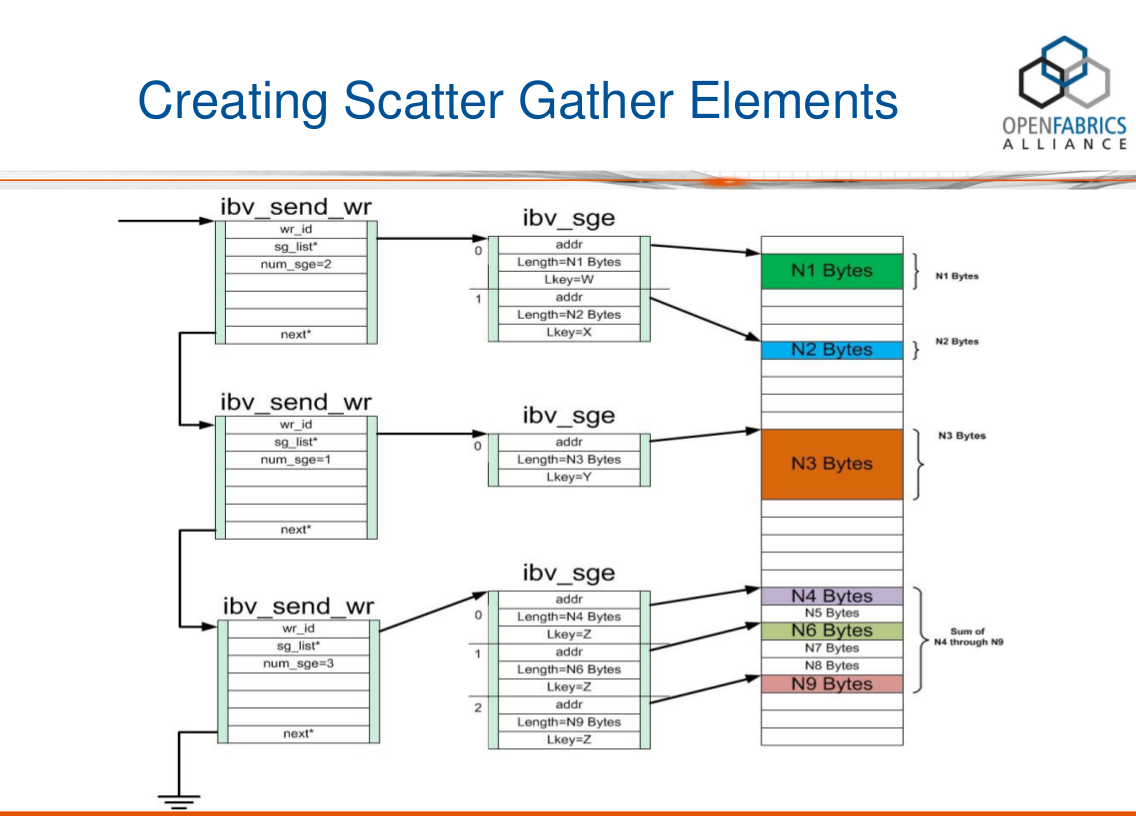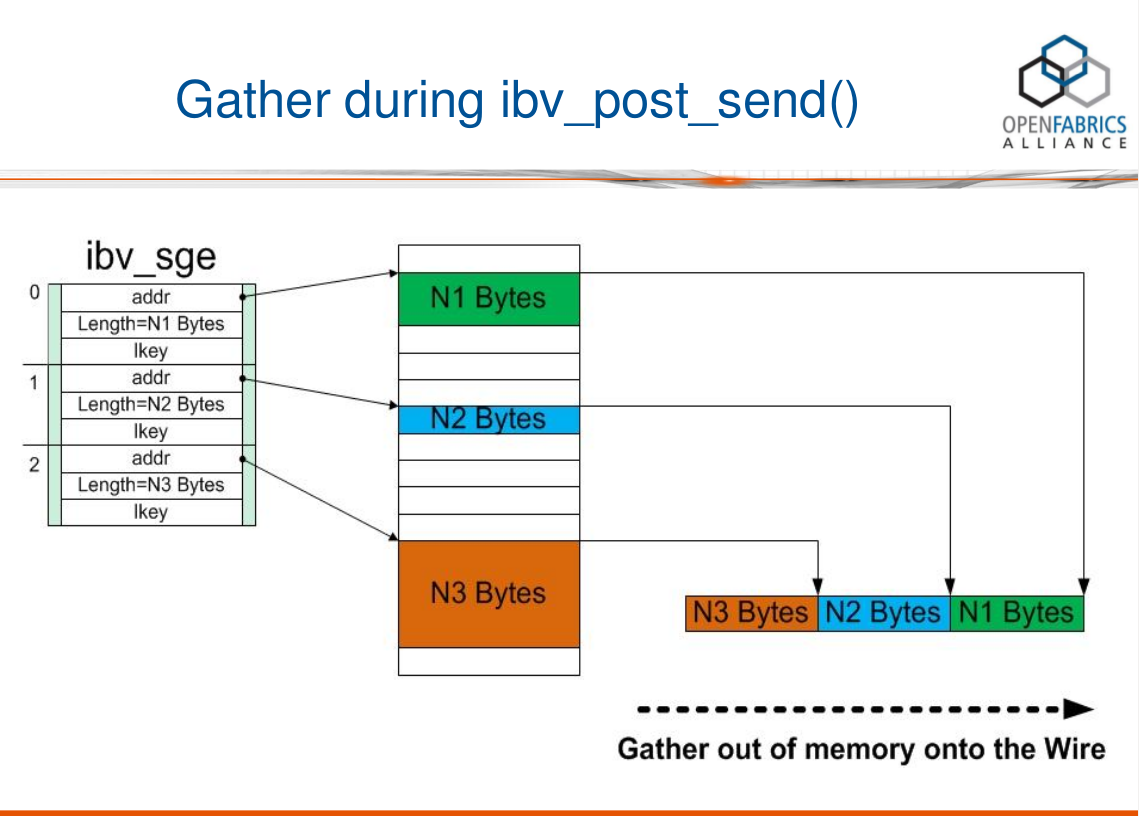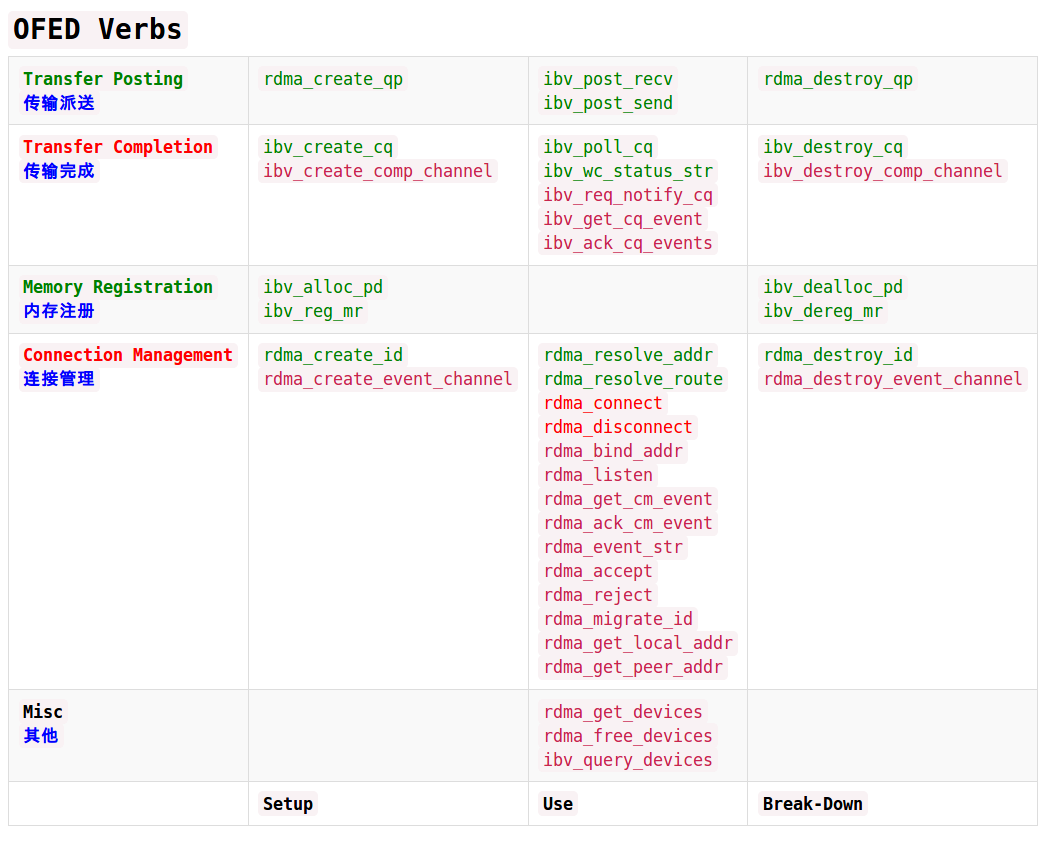在NVMe over PCIe中,I/O命令支持SGL(Scatter Gather List 分散聚合表)和PRP(Physical Region Page 物理(内存)区域页), 而管理命令只支持PRP;而在NVMe over Fabrics中,无论是管理命令还是I/O命令都只支持SGL。NVMe over Fabrics既支持FC网络,又支持RDMA网络。众所周知,在RDMA编程中,SGL(Scatter/Gather List)是最基本的数据组织形式。 SGL是一个数组,该数组中的元素被称之为SGE(Scatter/Gather Element),每一个SGE就是一个Data Segment(数据段)。其中,SGE的定义如下(参见verbs.h):
struct ibv_sge { uint64_t addr; uint32_t length; uint32_t lkey; };
- addr: 数据段所在的虚拟内存的起始地址 (Virtual Address of the Data Segment (i.e. Buffer))
- length: 数据段长度(Length of the Data Segment)
- lkey: 该数据段对应的L_Key (Key of the local Memory Region)
而在数据传输中,发送/接收使用的Verbs API为:
- ibv_post_send() - post a list of work requests (WRs) to a send queue 将一个WR列表放置到发送队列中
- ibv_post_recv() - post a list of work requests (WRs) to a receive queue 将一个WR列表放置到接收队列中
下面以ibv_post_send()为例,说明SGL是如何被放置到RDMA硬件的线缆(Wire)上的。
- ibv_post_send()的函数原型
#include <infiniband/verbs.h> int ibv_post_send(struct ibv_qp *qp, struct ibv_send_wr *wr, struct ibv_send_wr **bad_wr);
ibv_post_send() posts the linked list of work requests (WRs) starting with wr to the send queue of the queue pair qp. It stops processing WRs from this list at the first failure (that can be detected immediately while requests are being posted), and returns this failing WR through bad_wr.
The argument wr is an ibv_send_wr struct, as defined in <infiniband/verbs.h>.
struct ibv_send_wr { uint64_t wr_id; /* User defined WR ID */ struct ibv_send_wr *next; /* Pointer to next WR in list, NULL if last WR */ struct ibv_sge *sg_list; /* Pointer to the s/g array */ int num_sge; /* Size of the s/g array */ enum ibv_wr_opcode opcode; /* Operation type */ int send_flags; /* Flags of the WR properties */ uint32_t imm_data; /* Immediate data (in network byte order) */ union { struct { uint64_t remote_addr; /* Start address of remote memory buffer */ uint32_t rkey; /* Key of the remote Memory Region */ } rdma; struct { uint64_t remote_addr; /* Start address of remote memory buffer */ uint64_t compare_add; /* Compare operand */ uint64_t swap; /* Swap operand */ uint32_t rkey; /* Key of the remote Memory Region */ } atomic; struct { struct ibv_ah *ah; /* Address handle (AH) for the remote node address */ uint32_t remote_qpn; /* QP number of the destination QP */ uint32_t remote_qkey; /* Q_Key number of the destination QP */ } ud; } wr; }; struct ibv_sge { uint64_t addr; /* Start address of the local memory buffer */ uint32_t length; /* Length of the buffer */ uint32_t lkey; /* Key of the local Memory Region */ };
在调用ibv_post_send()之前,必须填充好数据结构wr。 wr是一个链表,每一个结点包含了一个sg_list(i.e. SGL: 由一个或多个SGE构成的数组), sg_list的长度为num_sge。

下面图解一下SGL和WR链表的对应关系,并说明一个SGL (struct ibv_sge *sg_list)里包含的多个数据段是如何被RDMA硬件聚合成一个连续的数据段的。
- 01 - 创建SGL

从上图中,我们可以看到wr链表中的每一个结点都包含了一个SGL,SGL是一个数组,包含一个或多个SGE。
- 02 - 使用PD做内存保护

一个SGL至少被一个MR保护, 多个MR存在同一个PD中。
- 03 - 调用ibv_post_send()将SGL发送到wire上去

在上图中,一个SGL数组包含了3个SGE, 长度分别为N1, N2, N3字节。我们可以看到,这3个buffer并不连续,它们Scatter(分散)在内存中的各个地方。RDMA硬件读取到SGL后,进行Gather(聚合)操作,于是在RDMA硬件的Wire上看到的就是N3+N2+N1个连续的字节。换句话说,通过使用SGL, 我们可以把分散(Scatter)在内存中的多个数据段(不连续)交给RDMA硬件去聚合(Gather)成连续的数据段。
最后,作为一个代码控(不喜欢纸上谈兵),贴一小段代码展示一下如何为调用ibv_post_send()准备SGL和WR以加深理解。
1 #define BUFFER_SIZE 1024 2 3 struct connection { 4 struct rdma_cm_id *id; 5 struct ibv_qp *qp; 6 7 struct ibv_mr *recv_mr; 8 struct ibv_mr *send_mr; 9 10 char recv_region[BUFFER_SIZE]; 11 char send_region[BUFFER_SIZE]; 12 13 int num_completions; 14 }; 15 16 void foo_send(void *context) 17 { 18 struct connection *conn = (struct connection *)context; 19 20 /* 1. Fill the array SGL having only one element */ 21 struct ibv_sge sge; 22 23 memset(&sge, 0, sizeof(sge)); 24 sge.addr = (uintptr_t)conn->send_region; 25 sge.length = BUFFER_SIZE; 26 sge.lkey = conn->send_mr->lkey; 27 28 /* 2. Fill the singly-linked list WR having only one node */ 29 struct ibv_send_wr wr; 30 struct ibv_send_wr *bad_wr = NULL; 31 32 memset(&wr, 0, sizeof(wr)); 33 wr.wr_id = (uintptr_t)conn; 34 wr.opcode = IBV_WR_SEND; 35 wr.sg_list = &sge; 36 wr.num_sge = 1; 37 wr.send_flags = IBV_SEND_SIGNALED; 38 39 /* 3. Now send ... */ 40 ibv_post_send(conn->qp, &wr, &bad_wr); 41 42 ...<snip>... 43 }
附录一: OFED Verbs

A great ship asks deep waters. | 是大船就得走深水,是蛟龙就得去大海里畅游。